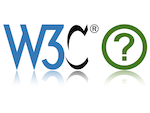W3C and WHATWG to work together to advance the open Web platform
I am pleased to announce that W3C and the WHATWG have just signed an agreement to collaborate on the development of a single version of the HTML and DOM specifications. The Memorandum of Understanding jointly published as the WHATWG/W3C Joint Working Mode gives the specifics of this collaboration.
Motivated by the belief that having two distinct HTML and DOM specifications claiming to be normative is generally harmful for the community, and the mutual desire to bring the work back together, W3C and WHATWG agree to the following terms:
- W3C and WHATWG work together on HTML and DOM, in the WHATWG repositories, to produce a Living Standard and Recommendation/Review Draft-snapshots
- WHATWG maintains the HTML and DOM Living Standards
- W3C facilitates community work directly in the WHATWG repositories (bridging communities, developing use cases, filing issues, writing tests, mediating issue resolution)
- W3C stops independent publishing of a designated list of specifications related to HTML and DOM and instead will work to take WHATWG Review Drafts to W3C Recommendations
Additional aspects of the collaboration include:
- WHATWG produces periodic snapshots, called Review Drafts, for a patent exclusion opportunity; W3C selects those to be Candidate Recommendations, which follow the W3C process (Candidate Recommendation → Proposed Recommendation → Recommendation). The W3C CR, PR, and REC, and the WHATWG Review Draft are the same document
- /TR (All Standards and Drafts) will point to whatwg.org for HTML and DOM
- There is a resolution process in case of sustained disagreements (escalation to the WHATWG Steering Group, TAG review, and W3C Director) and if no agreement is reached, either side may terminate the agreement if a fork is published
- Joint copyright and branding of the single documents (Review Drafts/Recommendations)
- Use of annotations for features without Implementation Experience
- Different formatting of W3C Recs on whatwg.org
- Update to W3C's Normative Reference Policy to allow reference to stable features in Living Standards
The HTML Working Group which we will soon recharter will assist the W3C community in raising issues and proposing solutions for the HTML and DOM specifications, and bring WHATWG Review Drafts to Recommendation.
W3C and WHATWG had been exploring effective partnership mechanisms since December 2017 after the WHATWG adopted many shared features as their work-mode and an IPR policy. Since then, W3C Membership weighed in regularly including at two bi-annual meetings; there were several direct meetings between W3C management and the WHATWG Steering Group; in September and December 2018 during the extensions of the Web Platform Working Group, we noted that while negotiations continued in order to provide a single authoritative specification for HTML and DOM, the specifications that were part of the negotiations with the WHATWG would not be advanced on the W3C Recommendation track.
W3C remains committed to ensuring that HTML development continues to take into account the needs of the global community, and continues to improve in areas such as accessibility, internationalization and privacy while providing greater interoperability, performance and security.
欢迎参阅以上博文的中文译文。

Please don't take documentation of the WHATWG. From my own experience, this documentation is very difficult for comprehension, much more difficult, than documentation of the W3C.
Maybe you need MDN
If I said I didn't see this coming, I would be lying.
A CONSORTIUM handing over the reigns to the development of a core set of specifications to a renegade WORKING GROUP.
Much like in high school, the NERDs of the W3C has decided to relegate themselves to the JOCKs of the WHATWG.
Use any amount of fancy wording and explanations you can dream up, the simple fact is the W3C has just kowtowed to a working group that has little to no respect for the W3C.
The fact that HTML 5.2 allows for heading elements (H1 - H6), which implies sections, inside a LEGEND element is demonstrative of what happens when you build something that is not based on a standard.
"The W3C mission is to LEAD the World Wide Web to its full potential by developing protocols and guidelines..."
I capitalized the word Lead because turning over development of the core specification to a bunch of renegades bullying their way into acceptance is not leading.
The boss doing the secretary's work is not leading. The parent allowing the crying fat baby to eat cookies is not leading.
A consortium allowing a working group who disrespected it every step of the way is not leading.
It's simply being subjugated. Call it what you like.
HTML is indeed a vital specification but coordination and agreement are important and the Web is strongest when the many work together. Divisions and contentiousness do not help advance the Web and there is much work to be done by many organizations. W3C will coordinate with WHATWG to ensure the HTML5 specification reflects core values of W3C and our community such as accessibility, security and public feedback.
W3C will work to take WHATWG Review Drafts to W3C Recommendations and the W3C HTML Working Group will assist the W3C community in raising issues and proposing solutions for the HTML and DOM specifications. W3C will facilitate community work directly in the WHATWG repositories to bridge communities, develop use cases, file issues, write tests, and mediate issue resolution. The change means that similar specifications won’t be published in two places however, W3C will keep an active and central role in the work of HTML and DOM. Additionally, if the W3C community does not endorse a spec, then the W3C will not endorse it as a recommendation.
W3C will continue, as we have been, to lead and innovate the Open Web Platform with more than 300 specifications including SVG, CSS, Web Payments, Web Security, Web and Automotive, etc. for the good of users and the Web.